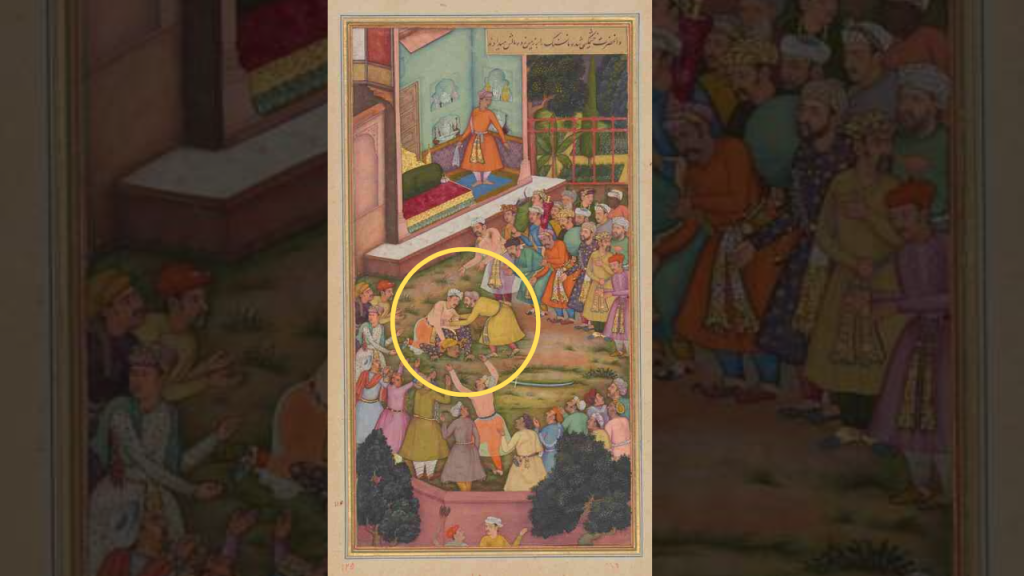Introduction
One among the plaster castes that loom over readers in a Dublin library, a 17th-century miniature painting shows an image all too recognizable to today’s tipplers down the pub: a ruckus. The image, called ‘Akbarnama: Akbar Fights Man Singh of Amber at a Drinking Party’, from the illustrated Akbarnama series shows the Mughal emperor Akbar and the maharaja of Amber in an angry confrontation. Among courtiers caught up in the brawl, it provides a colourful example of a particular incident from Akbar’s life to illustrate ideas of kingship, masculinity and politics.
Historical Context and Artistic Interpretation
For the painting meaning, we have to search into the history of Akbar described by Abu’l Fazl. When the emperor of Mughal tried to attack Surat in 1573, they were having dinner and at that time some Rajput nobles claimed their bravery. Akbar, in a drunken burst of bravado, prepared to charge towards an oncoming double-headed spear to prove his valour. One of his best friends, from the Amber royal family—Raja Man Singh intervened to save him from even further. This resulted into a tussle between the two and saw Akbar land on top of Man Singh after which recounted this story.
However, a miniature paints 25 years after by Dawlat depicts the event but with important variation from Abu’l Fazl’s first hand account of the battle. Though the text provides a more equitable presentation of the dominator vs submitter, the painting tilts heavily in Akbar’s favor, casting him as a foreign apparatchik. The fact that the emperor was unarmed may indirectly suggest Man Singh’s intervention, and in a somewhat milder version of Akbar’s rage than Abu’l Fazl conveyed.
The Art of Masculinity and Sovereignty
The representation of this custle in the miniature is not only a tale of shamefull incident but it is also a personification of Akbar ruler. Historian Dipanwita Donne writes that both Akbar and Maan Singh was a powerful personality with their domains and influences. While their fight was behind closed doors, it represented a display in public of testosterone and control. We are to be educated by seeing what it is like being emperor Akbar responsible for well manning his court and presenting himself as a reigning sun, queen, regardless of inner struggle.

The painting of course, shows how Akbar’s rule was based on the amalgamation of Indo-Muslim and Rajput masculinities. This complex interaction between the manliness and kingship is evident when Akbar emulates Rajput martiality, without compromising his imperial authority. The miniature thus serves as a theater for engaging with diverse discourses of masculine honor, and by extension also kingship.
The Semiotics of Rage and Regality
The painting of Dawlat also speaks in the idiom of anger and royal mien. Abu’l Fazl describes Akbar’s rage in explicit language, but here is the composed and dignified painting by Kishan Dass. This shift is in accordance with the Persianate, or Indian traditions of sovereignty, that valued temperance over unbridled anger. Akbar is painted as veering more toward ambivalence than anger, this hypocrisy being from the painting a symbol of his fatherly and sovereign authority over both the court and also himself.
Exclusion and Privacy in Royal Imagery
Two figures at the bottom of the painting stand beside the palace, watching but not engaging with what is going on. This little nuance makes the emperor’s public and personal lives apart. An intimate interlude between imperial visits, this scene provides a rare peek into the emperor’s bedroom and Akbar is shown to be vulnerable within its four walls but we are also made to realise that while the viewer’s access to some of his private moments may be superficial, so too (we soon find out) is our knowledge of his life outside these chambers.
Conclusion
This miniature painting of the fight between Akbar and Man Singh is an insight into the world of the Mughal Emperor. In illustrating this apparently inconsequential event with a sophisticated exploration of masculinity and kingship, the painting captures both the private and public dynamics during Akbar’s rule. A mixture of human fallibility and the grandeur of imperial authority, these entries provide angles through which one can reflect on how Akbar was being made and displayed.
Even as it decodes the finer nuances of what masculinity means and what kingship perhaps entails, this unveiling of Akbar in art tells us something more about the man behind the throne. Kamayani Sharma writes for Scroll, quoting the painting — reminding us that even Shahenshahs have their moments of drunken folly; to all human experiences are timeless and above rank.To read the full article on Scroll. Click Here





